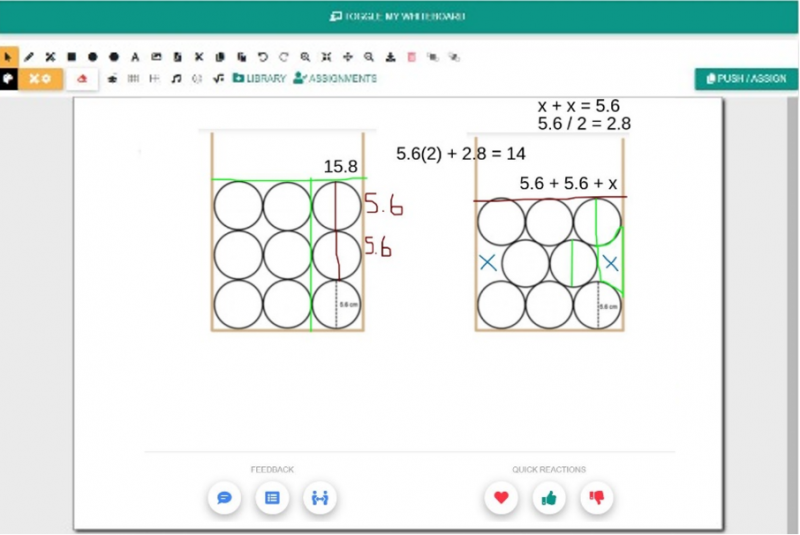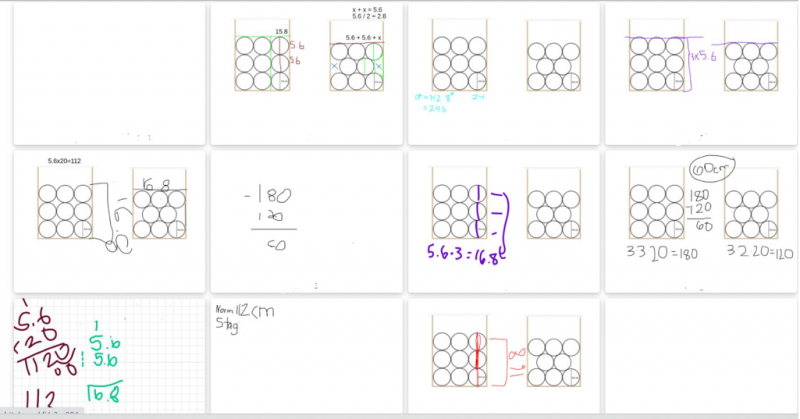Using Interactive Whiteboards with Mathematics Teachers and Students
Using Interactive Whiteboards with Mathematics Teachers and Students
In this blog post, we (1) describe the technological tool of interactive whiteboards, (2) summarize how interactive whiteboards can be used to teach mathematics in ways aligned with research, (3) overview the top free interactive whiteboard platforms available in Sept. 2021, and (4) explain how we have used digital whiteboards in our work with mathematics teachers and students.
1. What are interactive whiteboards?
Interactive whiteboards are digital environments with multimodal features (text, images, symbols, drawings) that provide a shared space between teacher and learners that is both accessible and directly manipulative (De Vita et al., 2018). Students can collaboratively edit a digital whiteboard to share ideas, solve problems, or reach a consensus in small groups. Interactive whiteboards can usually be saved and exported for continued work, sharing, and archiving. Figure 1 shows an example of how we used an interactive whiteboard with high school students solving the staggered pipe problem, and Figure 2 displays the teacher overview page to see our entire class of students’ work.
Figure 1: Example of collaborative work being completed on the interactive whiteboards platform Whiteboard.fi, with the teacher feedback options shown at the bottom.

Figure 2: The teacher view from Whiteboard.fi, displaying a class of students’ work.

2. What does research say about using whiteboards for teaching mathematics?
From research on traditional/physical interactive whiteboards (e.g. Smartboards), we know these tools can be used to support students’ academic achievement, positive attitudes, classroom management, knowledge construction, learner engagement and interactivity, motivation, and visual quality (Balta & Duran, 2015; Higgins, 2010; Holmes, 2009; İpek & Sözcü, 2016; Warwick et al. 2011). We also know traditional/physical interactive whiteboards can reinforce traditional, teacher-centered pedagogical styles, as often only teachers control the board and students begin focusing only on visual appeal rather than the content itself (Holmes, 2009; Smith et al., 2005, 2006; Torff & Tirotta, 2010). Just like other technological tools, the key in whiteboard effectiveness is about how teachers use the tool.
As for digital interactive whiteboards (e.g. Whiteboard.fi), there are similar themes, though less research is available (Erdener & Kandemir, 2019). When used with active and collaborative pedagogical approaches, interactive digital whiteboards can help students to improve their cognitive learning across all currently available interdisciplinary research reports (Shi, et al., 2021). Like other technological tools, frequency of use impacts students’ perceived efficiency and perceived learning (Fuchs, 2021). Effective patterns for using interactive whiteboards in mathematics occur in ways supporting research-based practices, for example supporting problem-solving and for organizing mathematical work, reflections, and representations (De Vita et al., 2018; Kutluca et al., 2019; Kohen, 2019; Shi et al., 2018, 2021).
Incorporating interactive whiteboards in classroom instruction can align with research-based practices overviewed in the Mathematics Teaching Principles (NCTM, 2014). Teachers can provide students opportunities to engage in productive struggle as they collaboratively tackle mathematical ideas and problem solve on the whiteboards (De Vita et al., 2018). Teachers can elicit and use evidence of student thinking by saving, sharing, and reviewing student work completed on the whiteboard during instructional time or completed outside of class. The use of whiteboards can facilitate mathematical discourse by allowing students the opportunity to share and build upon ideas together by analyzing and comparing mathematical work in real time (Ball et al., 2018).
3. What is the best interactive whiteboard platform for teaching mathematics?
Several interactive whiteboard platforms currently exist. Table 1 overviews the pros and cons of several currently available digital whiteboards. Our evaluation was conducted in September 2021; given the rapid change of these technologies, the information might become outdated as features, pricing models, and websites come and go. Note we evaluated only the free version of each whiteboard platform and ranked our listing from the best to worst for working with mathematics teachers, and for mathematics teachers using the platform within professional learning contexts or using the platform to teach students mathematics. We also ran the list by 20 in-service mathematics teachers, who supported the ranking.
Table 1: Our top 5 interactive whiteboard platforms, ranked based on their free version’s ability to facilitate mathematics instruction.
|
Whiteboard |
Pros of free version |
Cons of free version |
|---|---|---|
|
1. Whiteboard.fi
|
|
|
|
2. Microsoft Whiteboard https://www.microsoft.com/en-us/microsoft-365/microsoft-whiteboard/digital-whiteboard-app
|
|
|
|
3. Limnu
|
|
|
|
4. Jamboard
|
|
|
|
5. Ziteboard
|
|
|
Here are other interactive whiteboards we evaluated but did not make our top list:
4. How might you use interactive whiteboards within mathematics teacher education?
With students: As education is evolving, teachers continually seek to improve instructional strategies to reach all students. Learning to reach students both virtually and in-person has challenged us to pursue engaging ways to connect with our students. It is critical that teachers employ methods to formatively assess our students, and interactive whiteboards give us the opportunity to collaboratively work with students throughout a lesson to gain an understanding of their comprehension. These whiteboards allow us to individually reach out to students during a lesson to answer questions or make corrections to student work in real time. This can be particularly beneficial when teaching students virtually. We can see the students’ thought process as they work and help guide students back on track if they become puzzled while working or are unsure how to proceed on a particular problem. It brings the virtual student into a more “in-person” environment to get the one-on-one support from their teacher, while also engaging the students in the classroom. We encourage teachers to consider the many ways virtual whiteboards might be incorporated to allow students to collaboratively problem solve, such as solving equations, labeling geometric figures, notating mathematical proofs, working alongside helpful images and figures, and interacting with virtual manipulatives.
Within PLCs: Students are not the only ones who can benefit from these interactive whiteboards – they are excellent for collaboration among teachers working in Professional Learning Communities (PLCs) and consistency teams. Teachers meeting face-to-face or virtually can utilize the interactive whiteboards to review student work as a team, plan and execute upcoming lessons, review and analyze formative assessment data, and much more. Most of the whiteboard programs allow you to save and share work, which means teachers can continue their collaboration at each PLC meeting. Whether teachers are presenting professional development to their colleagues or leading a grade-level instructional planning meeting, interactive whiteboards can improve collaboration and encourage creative work spaces for us to improve our instruction as we strive to reach all students in our classrooms.
Within professional development and coursework: Whether the coursework is for undergraduate pre-service teachers attaining initial certification, or in-service teachers attaining graduate degrees, interactive whiteboards have the ability to foster virtual collaboration on mathematical tasks and problems. We have used interactive whiteboards to facilitate problem solving within small groups during synchronous course meetings. In large or small group professional development sessions, interactive whiteboards are a strong tool to link teachers’ ideas together as they work collaboratively. Teachers have the ability to work, plan, and edit during the PD session, then save and continue their work when they get back to their PLC, all via the interactive whiteboard. Whiteboards can also be helpful in connecting instructors with learners during online coursework or professional development, as it gives the instructor the ability to watch as the learners work together and share ideas. Instructors can then adjust and/or pivot the training, real-time, to meet their learners where they are in the learning process.
References
Ball, L., Drijvers, P., Ladel, S., Siller, H. S., Tabach, M., & Vale, C. (2018). Uses of technology in primary and secondary mathematics education. Cham, Switzerland: Springer.
Balta, N., & Duran, M. (2015). Attitudes of students and teachers towards the use of interactive whiteboards in elementary and secondary school classrooms. TOJET: The Turkish Online Journal of Educational Technology, 14(2), 15-23.
De Vita, M., Verschaffel, L., & Elen, J. (2018). The power of interactive whiteboards for secondary mathematics teaching: Two case studies. Journal of Educational Technology Systems, 47(1), 50–78.
Erdener, K., & Kandemir, M. A. (2019). Investigation of the reasons for students’ attitudes towards the interactive whiteboard use in mathematics classrooms. International Journal of Research in Education and Science, 5(1), 331–345.
Fuchs, K. (2021). Preparing students for success in a changing world: The role of virtual whiteboards in the modern classroom. Education Quarterly Reviews, 4(1).
Higgins, S. (2010) The impact of interactive whiteboards on classroom interaction and learning in primary schools in the UK. In M. Thomas & E. C. Schmid (Eds.), Interactive Whiteboards for Education: Theory, Research and Practice (pp. 86-101). Hershey, PA: IGI Global.
Holmes, K. (2009). Planning to teach with digital tools: Introducing the interactive whiteboard to pre-service secondary mathematics teachers. Australasian Journal of Educational Technology, 25(3), 351-365.
İpek, İ., & Sözcü, Ö. F. (2016). Preferences and attitudes for using interactive whiteboards in different courses and learning. European Journal of Contemporary Education, 15(1), 173-184.
Kohen, Z. (2019). Informed integration of IWB technology, incorporated with exposure to varied mathematics problem-solving skills: its effect on students’ real-time emotions. International Journal of Mathematical Education in Science and Technology, 50(8), 1128-1151.
Kutluca, T., Yalman, M., & Tum, A. (2019). Use of interactive whiteboard in teaching mathematics for sustainability and its effect on the role of teacher. Discourse and Communication for Sustainable Education, 10(1), 113-132.
National Council of Teachers of Mathematics (2014). Principles to actions: Ensuring mathematical success for all. Reston, VA: NCTM.
Shi, Y., Peng, C., Yang, H. H., & MacLeod, J. (2018). Examining interactive whiteboard-based instruction on the academic self-efficacy, academic press and achievement of college students. Open Learning: The Journal of Open, Distance and e-Learning, 33(2), 115-130.
Shi, Y., Zhang, J., Yang, H., & Yang, H. H. (2021). Effects of interactive whiteboard-based instruction on students’ cognitive learning outcomes: A meta-analysis. Interactive Learning Environments, 29(2), 283-300.
Smith, H. J., Higgins, S., Wall, K. & Miller, J. (2005). Interactive whiteboards: Boon or bandwagon? A critical review of the literature. Journal of Computer Assisted Learning, 21, 91- 101.
Smith, F., Hardman, F. & Higgins, S. (2006). The impact of interactive whiteboards on teacher-pupil interaction in the National Literacy and Numeracy Strategies. British Educational Research Journal, 32(3), 443-457.
Torff, B., & Tirotta, R. (2010). Interactive whiteboards produce small gains in elementary students’ self-reported motivation in mathematics. Computers & Education, 54(2), 379-383.
Warwick, P., Hennessy, S., & Mercer, N. (2011). Promoting teacher and school development through co-enquiry: Developing interactive whiteboard use in a ‘dialogic classroom’. Teachers and Teaching: theory and practice, 17(3), 303–324.
